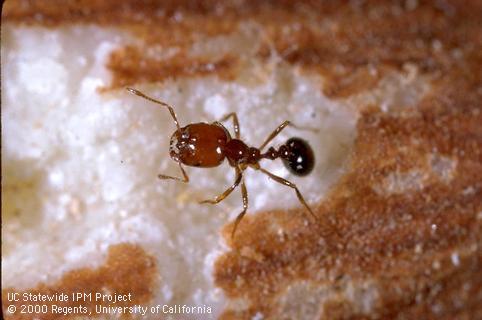Southern Fire Ant
September 11, 2002
The Southern Fire Ant, Kern County's Native Cousin to the Red Imported Fire Ant
The southern fire ant, Solenopsis xyloni, is a common, native ant to Kern County. It is often confused with the red imported fire ant, Solenopsis invicta, which has become a significant pest throughout the Gulf States. Both ant species are recognized by the painful bite and sting they can inflict to humans and other animals that disturb them. Currently, government agencies in California are unaware of any red imported fire ants in Kern County.The southern fire ant can be distinguished from other ants in Kern County. Fire ants have a red to amber head, while the abdomen is almost completely black. Worker ants range in size from 1/8 to more than 1/4 inch long and do not form trails. Workers of most other native ants are all the same size. Mounds of the southern fire ant look like small craters with a centralized hole. Each colony can produce several of these small crater entrances. When disturbed, fire ants will swarm out of their nests to defend the colony. Once an intruder is identified, the ants will gain leverage by biting and locking onto the object and then inflicting a painful sting.
The best response to ant stings is to immediately get away from the ant-infested area and then brush the ants from your skin and clothing. Small children should always be supervised, since their natural response to ant stings is to panic and freeze in place. Ant stings, though painful, generally do not require medical treatment. Exceptions may occur in cases when an individual receives numerous stings, or for a minority of individuals that are allergic to bites or stings by insects.
Southern fire ants are generally only a problem outdoors. They are most active in the early morning and in the evening, and hide underground during the heat of the day. Workers forage for a variety of foods. Examples are other insects, seeds, proteins, and sweet foods including insect honeydew. Periodically these ants will enter into homes to find additional food sources.
Fire ants can be managed through a combination of sanitation and insecticides. Management inside the home should focus on keeping the ants out. Food products should be promptly cleaned up and garbage should be removed in a timely manner. Entryways into the home can also be sealed shut with calking in order to provide a barrier against their entry. Worker ants inside a home can be cleaned up with a sponge and soapy water.
Insecticides are the most effective tools for managing fire ants in the outdoors. Granular baits laced with the chemical ingredients hydramethylnon or fipronil provide the best control. Granular baits should be broadcast over the whole area where the ants forage. Worker ants take the bait back into the colony where the ants will feed and die within a few weeks. Insecticides that immediately kill worker ants are of little value, as they can only kill a minority of the worker ants that are above ground, and have no effect on the queen. Baits should not be used indoors, or in areas that are accessible to children or pets. They work best when they remain dry, and are best applied in the evening when the ants are most active.
By: David Haviland, UCCE Advisor, Kern County Entomology and Pest Management

